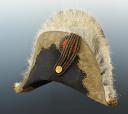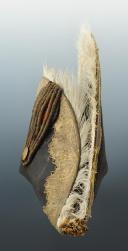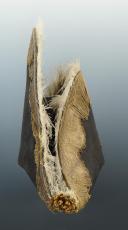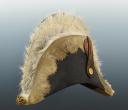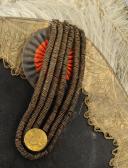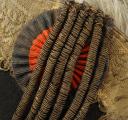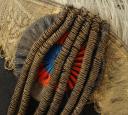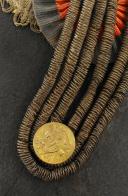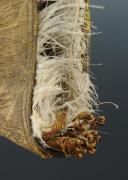
BICORNE HAT OF A GENERAL-IN-CHIEF COMMANDING AN ARMY CORPS, FIRST EMPIRE.
Sold out
BICORNE HAT OF A CHIEF GENERAL COMMANDING AN ARMY CORPS, FIRST EMPIRE.
Black "flamand" felt hat. Height from the front starting from the curved part 19 cm, Height from the front starting from the bottom of the horns 25.5 cm. Height from the back starting from the curved part 26.5 cm, Height from the back starting from the bottom of the horns 34.5 cm. Width 46 cm. Depth of the headband 17.5 cm. It is bordered with a gold lace (width 7.7 cm) with scalloped edges and crests, woven with an oak branch with its fruits. A curly white ostrich feather is sewn against each of the inner edges.
Chinstrap formed of three matte gold twists, doubling around the uniform button and secured by the same button.
Large gilded uniform button, 1804 model: half-domed, gilded, burnished and mat, embossed with a trophy formed of flags and a shield stamped with the initials "E. F." (French Empire) and surmounted by a helmet, all placed on a bundle of winged fasces (diameter 2.7 cm).
Cockade in tricolor trimming, silver on the outside then scarlet and national blue on the inside (diameter 7.7 cm).
Interior headpiece composed of a black waxed leather turban (height 5.4 cm) and trimmed with black silk with a black printed paper label "HERBULOT, ... Cr du Sr DAYDÉ: Hat Maker Rue Nve St Roch No. 43 in PARIS".
Each horn is trimmed with a large bobble of golden trimmings.
Very good condition, slight oxidation of the trimmings, wear on the feathers.
France.
First Empire.
NOTE:
The dress code for general officers of the First Empire is derived from the regulations of 1 Vendémiaire An XII (24 September 1803). Originally, to distinguish the ranks of generals, a plume was to be added above the cockade of the hat. At the beginning of the Empire, the hats complied with the regulations, but the voluminous plumes prescribed by the regulation were quickly removed because they were very cumbersome, especially in strong winds. Deprived of these plumes, the hats no longer indicated the differences in ranks; chiefs of staff generals started the practice of adding a border of small white feathers to their hats, while division and brigade generals opted for black feathers. The informal hat is also adorned with feathers and may or may not have a border of black silk ribbon.
This model of hat is likely one of the rarest regulation headwear pieces from the First Empire. To our knowledge, only a few authentic examples have reached us: the hat of Prince Jérôme-Napoléon, worn on the battlefield where he commanded the 6th division of the 2nd Army Corps of Rieille, currently preserved in the Napoleon Museum at Château de la Pommerie, and the hat of General Nicolas Oudinot, commanding the 2nd Corps of the Grande Armée, preserved at the Army Museum, Hôtel des Invalides in Paris, inventory number A10425-15504.
This hat model is identical to the hat of the Marshals of France, except for the uniform button, which for the marshals features two crossed batons. The Army Museum has in its collections the hat of Marshal Lannes, donated in 1897 by the Duke of Montebello, inventory number 5707-Cc110.
Black "flamand" felt hat. Height from the front starting from the curved part 19 cm, Height from the front starting from the bottom of the horns 25.5 cm. Height from the back starting from the curved part 26.5 cm, Height from the back starting from the bottom of the horns 34.5 cm. Width 46 cm. Depth of the headband 17.5 cm. It is bordered with a gold lace (width 7.7 cm) with scalloped edges and crests, woven with an oak branch with its fruits. A curly white ostrich feather is sewn against each of the inner edges.
Chinstrap formed of three matte gold twists, doubling around the uniform button and secured by the same button.
Large gilded uniform button, 1804 model: half-domed, gilded, burnished and mat, embossed with a trophy formed of flags and a shield stamped with the initials "E. F." (French Empire) and surmounted by a helmet, all placed on a bundle of winged fasces (diameter 2.7 cm).
Cockade in tricolor trimming, silver on the outside then scarlet and national blue on the inside (diameter 7.7 cm).
Interior headpiece composed of a black waxed leather turban (height 5.4 cm) and trimmed with black silk with a black printed paper label "HERBULOT, ... Cr du Sr DAYDÉ: Hat Maker Rue Nve St Roch No. 43 in PARIS".
Each horn is trimmed with a large bobble of golden trimmings.
Very good condition, slight oxidation of the trimmings, wear on the feathers.
France.
First Empire.
NOTE:
The dress code for general officers of the First Empire is derived from the regulations of 1 Vendémiaire An XII (24 September 1803). Originally, to distinguish the ranks of generals, a plume was to be added above the cockade of the hat. At the beginning of the Empire, the hats complied with the regulations, but the voluminous plumes prescribed by the regulation were quickly removed because they were very cumbersome, especially in strong winds. Deprived of these plumes, the hats no longer indicated the differences in ranks; chiefs of staff generals started the practice of adding a border of small white feathers to their hats, while division and brigade generals opted for black feathers. The informal hat is also adorned with feathers and may or may not have a border of black silk ribbon.
This model of hat is likely one of the rarest regulation headwear pieces from the First Empire. To our knowledge, only a few authentic examples have reached us: the hat of Prince Jérôme-Napoléon, worn on the battlefield where he commanded the 6th division of the 2nd Army Corps of Rieille, currently preserved in the Napoleon Museum at Château de la Pommerie, and the hat of General Nicolas Oudinot, commanding the 2nd Corps of the Grande Armée, preserved at the Army Museum, Hôtel des Invalides in Paris, inventory number A10425-15504.
This hat model is identical to the hat of the Marshals of France, except for the uniform button, which for the marshals features two crossed batons. The Army Museum has in its collections the hat of Marshal Lannes, donated in 1897 by the Duke of Montebello, inventory number 5707-Cc110.
Reference :
8636
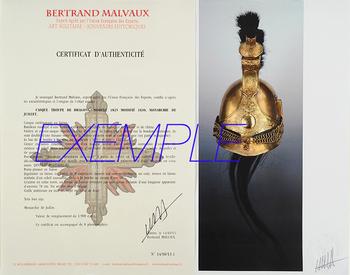
Next update Friday, december 26 at 13:30 PM
FOR ALL PURCHASES, PAYMENT IN MULTIPLE CHECKS POSSIBLE
bertrand.malvaux@wanadoo.fr 06 07 75 74 63
SHIPPING COSTS
Shipping costs are calculated only once per order for one or more items, all shipments are sent via registered mail, as this is the only way to have proof of dispatch and receipt.
For parcels whose value cannot be insured by the Post, shipments are entrusted to DHL or Fedex with real value insured, the service is of high quality but the cost is higher.
RETURN POLICY
Items can be returned within 8 days of receipt. They must be returned by registered mail at the sender's expense, in their original packaging, and in their original condition.
AUTHENTICITY
The selection of items offered on this site allows me to guarantee the authenticity of each piece described here, all items offered are guaranteed to be period and authentic, unless otherwise noted or restricted in the description.
An authenticity certificate of the item including the description published on the site, the period, the sale price, accompanied by one or more color photographs is automatically provided for any item priced over 130 euros. Below this price, each certificate is charged 5 euros.
Only items sold by me are subject to an authenticity certificate, I do not provide any expert reports for items sold by third parties (colleagues or collectors).
FOR ALL PURCHASES, PAYMENT IN MULTIPLE CHECKS POSSIBLE
bertrand.malvaux@wanadoo.fr 06 07 75 74 63
An authenticity certificate of the item including the description published on the site, the period, the sale price, accompanied by one or more color photographs is automatically provided for any item priced over 130 euros. Below this price, each certificate is charged 5 euros.
Only items sold by me are subject to an authenticity certificate, I do not provide any expert reports for items sold by third parties (colleagues or collectors).

